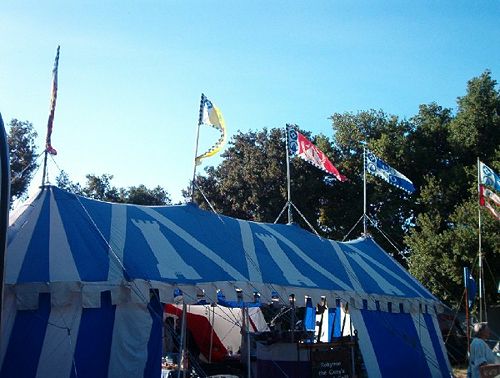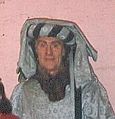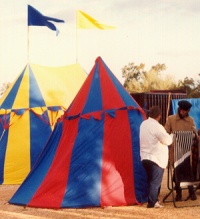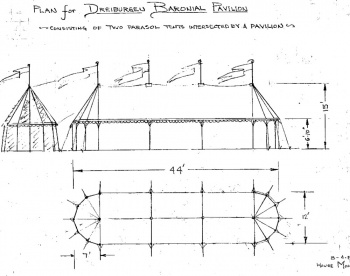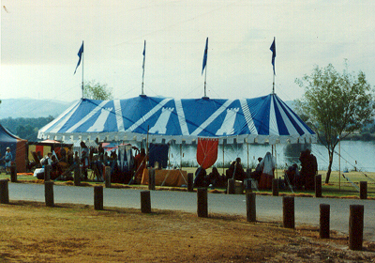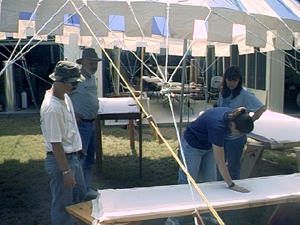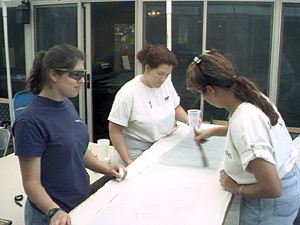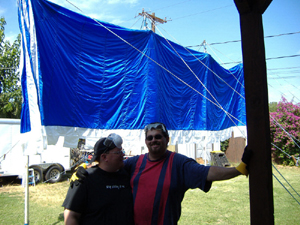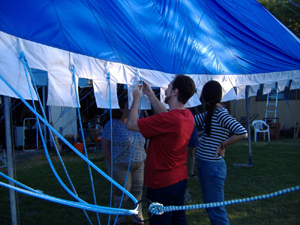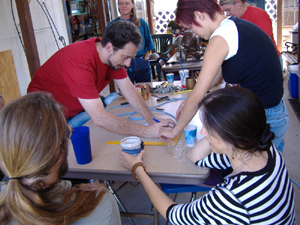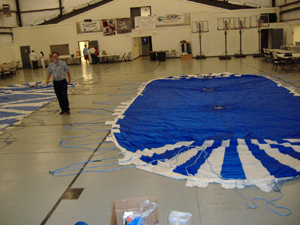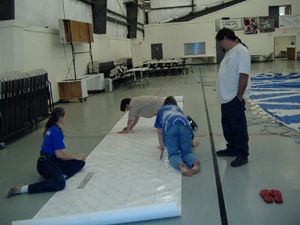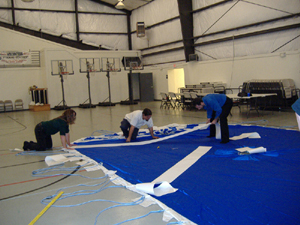Big Blue
The Dreiburgen Baronial Pavilion and how it grew
Written By Mornay of Anglesey & Malcolm AlbericRRE of House Montrose
Originally published in the Dreiburgen News A.S. XXV
Big Blue is Dreiburgen’s Largest Baronial Pavilion. It serves as the Baron’s Great Hall and as home to all members of the barony.
How It Grew
The new Dreiburgen pavilion was the culmination of at least five years of planning and working towards its financing, design and construction. The beginning started with the recognition that the barony was going to soon require a new pavilion. Back in 1985, when Lady Iana of Tallowcross was the baronial exchequer, it was decided to start accumulating funds for the new Baronial Pavilion.
Origins of the Design
Informal discussions took place between groups and individuals favoring different design approaches, but all seem to agree that something more imposing, a little larger and, if possible, more period looking than the sunshade type we were using was desired.
In 1988, as our treasury began to grow, more serious discussion took place about the type of pavilion we should make. The consensus at that Council meeting was that it should be as much "period-like" as possible. About this same time, we at Montrose were studying period pavilions and built a small, parasol type pavilion designed for two (four in a pinch)
that would emulate small period parasols, be put up by one person, and fit in the back of a small Honda Civic. We didn't know it then, but this was the original ancestor of the new Baronial Pavilion.
What this little tent proved was the practicality, durability and light-weight characteristics of ripstop, UV resistant, fire-retardant nylon as a good SCA pavilion material. It also stood up in high winds where some other SCA tents went down.
A few people pointed out that nylon is not "period." True. But, the SCA has always accepted "look alike" materials where practical considerations dictate. Nylon was developed to simulate silk. To illustrate how well nylon succeeded, Drusilla ran a contest at the Baron's War in Calafia where she found that many people confused various samples of silk for nylon, and nylon for silk.
In the "Western European Medieval Tents" section of "Tensile Architecture" by Phillip Drew, we learned that these tents were made of canvas painted with tar then covered with exotic cloth such as linen or silk for decorative purposes. Great! We could simulated the silk outer covering with the nylon and, for economy and practicality, eliminate the canvas underlayer.
In 1988, Leo de Coronado asked for sketches for a baronial pavilion. Several were submitted at a special meeting to consider the possibilities. We submitted a round-ended, four center pole design having a medieval, quadruple "crow's-foot," roof tie-down ropes and the walls separate from the roof as was virtually universal in medieval and renaissance tents. Our criteria was a large pavilion with a period look but light in weight and able to stand-up in the high winds encountered in Dreiburgen and other sites about the Southwest. Another requirement was that it should be possible to erect it with as few as two persons.
| >>>------------> |
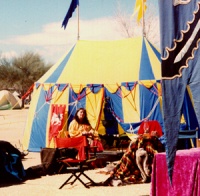
After these ideas had been submitted, Lady Lizbeth Ravensholm decided to build a pavilion and visited Montrose to firm up a design. She and Lord Aladric evolved a smaller version of the proposed Baronial Pavilion utilizing two central poles and having the walls sewn to the roof for simplicity. Many of you have seen this striking blue and yellow pavilion. She took it to Rowany in Australia where it survived both wind and rainy weather. This encouraged us in the adequacy of the basic design. Then in the fall of 1989, Baron Leo selected this type of design and, since the baronial treasury now had adequate funds, urged the start of the construction.
Pavilion Construction
After the holiday season and early events of the year, construction started in earnest in March with the purchase from Noah Lamport, Inc of 60 inch wide CPAI–84 flame retardant, UV coated, rip-stop nylon, 70 yards of white and 120 yards of blue nylon along with a roll of white insignia tape and 8 yards of white insignia cloth. Lord Aladric of Litchfield determined the dimensions for cutting the roof pieces and a day was spent using the parish hall floor of St. Michael's Episcopal Church for marking and cutting out the principal roof pieces.
Lord Wilhelm obtained the wood poles: both 1½ inch for wall support and the 2 inch diameter for the main center poles. Montrose (Lords Aladric of Litchfield, Mornay of Anglesey and Malcolm Alberic) obtained the metal parts: chain-link fence top rail and fittings for the side wall frame tops and posts for joining the sections of the center poles, pulleys for the top center post joiners and 3/4 inch electrical conduit for the end wall frame tops.
3/8 inch diameter polypropylene, hollow core blue/white rope was employed for the crows-foot tie-downs and hoisting the roof, and similar 1/4 inch diameter rope was used for erecting and wind bracing the central poles. Lord Aladric had to braid all of these crows feet and the hoisting ropes, a fair task all in itself. Some have speculated that the rope cost as much as the fabric and, while we certainly did have problems with the rope company delivering our blue and white cordage, this did not affect the cost which was only about 1/3 that of the fabric.
Lord Elgil Mardil of Dor-Mallos donated the many pieces of steel reinforcing bars used for tent stakes. These were cut, bent, hammered and welded by the Lords Malcolm, Aladric, Elgil, Eadwynne of Runedun, Quinton Reis and Thomas Bordeaux.
Pavilion Workers
The following members of the barony worked on this mammoth project which required several man-months of time. (A pavilion of this size is not recommended for any organization less than a barony and then only if a number of very dedicated and skilled people are available.) The following list includes all who worked at least an hour towards the construction of the Dreiburgen pavilion (some worked at least a man-week or more). This list is as complete as I could make it and if anyone has inadvertently been omitted or names misspelled they have my abject apologies.
Banners
When Big Blue was finished the four center poles were topped with four generic blue banners. There was much discussion on what type of banners should be on top. It was finally decided that since Dreiburgen had four cantons, Gallavally, Al-Sahid, Steinsee and Desert March that the perfect answer was to have a banner of each canton on the poles. The decision was that each pole would have a canton banner and each canton would be responsible for their own.
Time went by… and no banners were made. Al-Sahid became a shire and no banners. Then more time went by… Mons Draconis and Collegium Sancti Geronimi formed. Still no banners. Desert March disbanded and still no banners.
Then in 2002 Pagus Sancti Geronimi decided that the wait was over; not only would they make the Sancti Geronimi banner but they would make all four banners.
There were still four cantons, only now they were Gallavally, Steinsee, Sancti Geronimi and Mons Draconis. During a banner workshop that Sancti Geronimi setup with Baron Phillip and Baroness Rebecca, the banners were finally made after a long twelve-year wait.
Big Blue 2 the Redo!
After over 13 years of service "Big Blue", the Dreiburgen pavilion, started showing its age. The roof was failing and needed to be replaced. The populace, not wanting to loose their gathering place and primary symbol of their unity, rallied behind the roof replacement project.
Before the 643 man-hour project could begin, however, Lord Aladric of Litchfield, the chief engineer, needed to draft a new set of patterns. The problem was he could not find the time to do so. In the end he prayed to Saint Geronimus to help him find the time, and as our patron saint always does, he answered the prayer. Aladric promptly had an accident that broke his toe. Being stuck in a chair with his foot propped up he had nothing else to do but load AutoCAD in his laptop and lay out the pattern.
The following is a list of all those who worked so hard to keep Big Blue standing and thereby the barony together:
